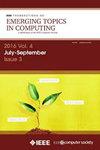以稀疏性为导向、以 MRAM 为中心的高效神经网络推理计算
IF 5.1
2区 计算机科学
Q1 COMPUTER SCIENCE, INFORMATION SYSTEMS
IEEE Transactions on Emerging Topics in Computing
Pub Date : 2023-10-26
DOI:10.1109/TETC.2023.3326312
引用次数: 0
摘要
近内存计算(NMC)和内存计算(IMC)范例在非冯-诺依曼体系结构中具有重要意义。自旋转移力矩磁随机存取存储器(STT-MRAM)被认为是实现资源受限应用的 NMC 和 IMC 的理想候选方案。在这项工作中,提出了两个以 MRAM 为中心的计算框架:三跳 NMC(TS-NMC)和模拟多位稀疏 IMC(AMS-IMC)。TS-NMC 利用激活和权重的稀疏性,通过稀疏标志发生器实现写入-读取-计算三重跳过计算方案。AMS-IMC 具有重新配置的计算位元和标志发生器,可在计算中适应位级激活稀疏性。STT-MRAM 阵列及其外围电路是通过 28 纳米 CMOS 工业设计套件和 MTJ 紧凑型模型实现的。与处理非零矢量相比,三跳方案在处理零矢量时可将内存访问能耗降低 51.5 倍。与传统的 NMC 框架和现有的模拟 IMC 框架相比,AMS-IMC 的能效分别提高了 5.9 倍和 1.5 倍(输入稀疏度为 75%)。验证结果表明,TS-NMC 和 AMS-IMC 在 MNIST 分类中的推理准确率分别达到了 98.6% 和 97.5%,能耗分别为 14.2 nJ/模式和 12.7 nJ/模式。本文章由计算机程序翻译,如有差异,请以英文原文为准。
Sparsity-Oriented MRAM-Centric Computing for Efficient Neural Network Inference
Near-memory computing (NMC) and in- memory computing (IMC) paradigms show great importance in non-von Neumann architecture. Spin-transfer torque magnetic random access memory (STT-MRAM) is considered as a promising candidate to realize both NMC and IMC for resource-constrained applications. In this work, two MRAM-centric computing frameworks are proposed: triple-skipping NMC (TS-NMC) and analog-multi-bit-sparsity IMC (AMS-IMC). The TS-NMC exploits the sparsity of activations and weights to implement a write-read-calculation triple skipping computing scheme by utilizing a sparse flag generator. The AMS-IMC with reconfigured computing bit-cell and flag generator accommodate bit-level activation sparsity in the computing. STT-MRAM array and its peripheral circuits are implemented with an industrial 28-nm CMOS design-kit and an MTJ compact model. The triple-skipping scheme can reduce memory access energy consumption by 51.5× when processing zero vectors, compared to processing non-zero vectors. The energy efficiency of AMS-IMC is improved by 5.9× and 1.5× (with 75% input sparsity) as compared to the conventional NMC framework and existing analog IMC framework. Verification results show that TS-NMC and AMS-IMC achieved 98.6% and 97.5% inference accuracy in MNIST classification, with energy consumption of 14.2 nJ/pattern and 12.7 nJ/pattern, respectively.
求助全文
通过发布文献求助,成功后即可免费获取论文全文。
去求助
来源期刊

IEEE Transactions on Emerging Topics in Computing
Computer Science-Computer Science (miscellaneous)
CiteScore
12.10
自引率
5.10%
发文量
113
期刊介绍:
IEEE Transactions on Emerging Topics in Computing publishes papers on emerging aspects of computer science, computing technology, and computing applications not currently covered by other IEEE Computer Society Transactions. Some examples of emerging topics in computing include: IT for Green, Synthetic and organic computing structures and systems, Advanced analytics, Social/occupational computing, Location-based/client computer systems, Morphic computer design, Electronic game systems, & Health-care IT.
 求助内容:
求助内容: 应助结果提醒方式:
应助结果提醒方式:


